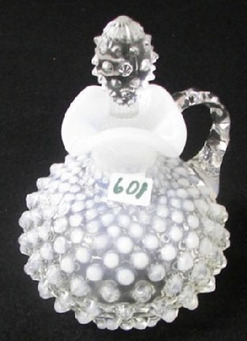 Hobnail glass is glass with a knobby surface, with an organized pattern of evenly spaced raised bumps. It takes its name from hobnail boots, work boots that were made more durable by the addition of hobnails in a regular pattern on the soles. (As mass production became more involved in the production of footware, the quality deteriorated and a rough sole of hobnails gave shoes a much-needed boost in terms of durability.)
Hobnail glass is glass with a knobby surface, with an organized pattern of evenly spaced raised bumps. It takes its name from hobnail boots, work boots that were made more durable by the addition of hobnails in a regular pattern on the soles. (As mass production became more involved in the production of footware, the quality deteriorated and a rough sole of hobnails gave shoes a much-needed boost in terms of durability.)
Production of hobnail glass involves either pressing or blowing glass into a mold and while others produced hobnail glass during the late Victorian era, it was the West Virginia-based Fenton Art Glass Company that would ultimately become synonymous with hobnail.
Fenton, founded in 1905, got a solid start with their innovative production of carnival glass, but by the 1930s, the Depression was threatening to “shatter” the glass industry. Glass had long offered smaller profit margins and the Depression-necessitated production of “Depression glass,” thin, inferior glass in washed out colors, left most glass companies struggling. Fenton had begun manufacturing some hobnail glass in 1935 and the company offered a hobnail design to the Wrisley Perfume Company in 1937. Wrisley, also desperately in need of a boost, felt the unique appearance of hobnail glass would boost sales, and when production started in 1938, no one was disappointed. The bottles manufactured for Wrisley sold with such success that Fenton opened up other lines of hobnail products, ultimately offering not just perfume bottles but ashtrays, candlesticks, lamps, vases, pitchers, jars and much more, all of which they would eventually offer in their iconic hobnail milk glass line, introduced in 1950.
In general, the ubiquity of hobnail glass keeps prices for pieces fairly affordable. Hobnail glass, Fenton’s pieces included, crowds the shelves at antique malls across the country. There are however some rarities, most notably Victorian-era pieces from the early years of production, typically hanging lamps, which can fetch several thousand dollars at auction. Rarer colors also confer the value of their association on hobnail designs, so colors like plum, which are seen less frequently than milk glass or cranberry, appeal to collectors and their pocketbooks.



